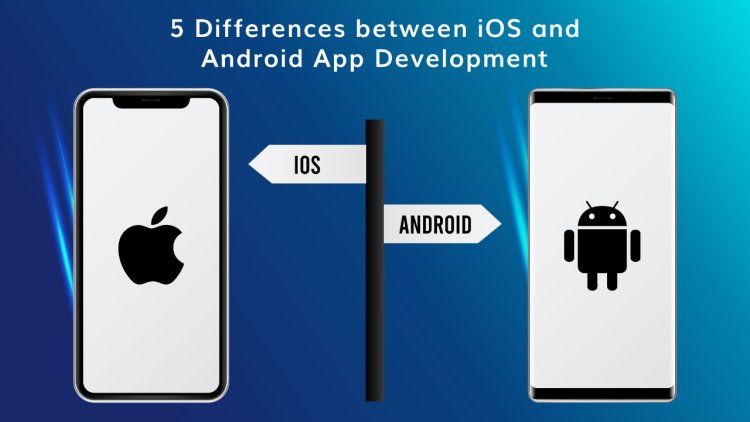5 Key Differences Between iOS and Android App Development
iOS app development in Dubai is a burgeoning field driven by the demand for innovative and user-friendly applications across the Apple ecosystem.
Share this Post to earn Money ( Upto ₹100 per 1000 Views )

iOS app development in Dubai is a burgeoning field driven by the demand for innovative and user-friendly applications across the Apple ecosystem. While both iOS and Android dominate the mobile app market, they differ significantly in terms of development processes, tools, and user interface guidelines. Understanding these differences is crucial for developers aiming to create successful applications on both platforms. Here are five key differences between iOS and Android app development that every developer should be aware of.
1. Programming Languages
iOS: iOS app development primarily uses Swift, a modern and powerful programming language introduced by Apple. Swift is designed to be safer, faster, and more concise than its predecessor Objective-C. Many developers prefer Swift for its ease of use and robust capabilities in building iOS applications.
Android: Android app development traditionally relied on Java, but Google now promotes Kotlin as the preferred language. Kotlin offers modern features, interoperability with Java, and enhanced safety checks. It has gained popularity among Android developers for its concise syntax and reduced boilerplate code.
Key Difference: While Swift is exclusive to iOS and macOS platforms, Kotlin can be used for both Android and server-side development. Developers transitioning between platforms may find Kotlin's versatility advantageous.
2. Integrated Development Environments (IDEs)
iOS: Xcode is the official IDE for iOS app development, providing a comprehensive set of tools for designing, coding, testing, and debugging apps. It includes features like Interface Builder for designing interfaces visually and Swift Playgrounds for experimenting with Swift code.
Android: Android Studio, based on IntelliJ IDEA, is the preferred IDE for Android developers. It offers a similar suite of tools, including a visual layout editor, APK analyzer, and emulators for testing apps on different Android devices and versions.
Key Difference: Xcode is tightly integrated with Apple's ecosystem, offering seamless development experiences for iOS, macOS, watchOS, and tvOS apps. Android Studio, on the other hand, supports a wide range of Android devices and configurations, reflecting the diversity of the Android ecosystem.
3. User Interface (UI) Design Guidelines
iOS: iOS follows Human Interface Guidelines (HIG), emphasizing clarity, depth, and intuitive navigation. iOS apps typically feature a consistent design language with clean layouts, minimalistic icons, and navigation patterns like tab bars and swipe gestures.
Android: Material Design guidelines govern Android app UI/UX, promoting visual hierarchy, motion, and responsive design principles. Material Design encourages bold colors, fluid animations, and adaptive layouts that adjust to different screen sizes and orientations.
Key Difference: Developers must adhere to each platform's UI guidelines to ensure apps feel native and intuitive. iOS apps prioritize simplicity and elegance, while Android apps focus on dynamic interfaces and visual appeal.
4. Fragmentation and Device Diversity
iOS: iOS devices, such as iPhones and iPads, are manufactured exclusively by Apple. This uniformity simplifies development, ensuring apps run smoothly across supported devices and iOS versions.
Android: Android operates on a wide range of devices from various manufacturers, leading to fragmentation in screen sizes, resolutions, and hardware capabilities. Developers must account for this diversity when optimizing apps for different devices.
Key Difference: iOS offers consistency in hardware and software, facilitating easier app optimization and compatibility testing. Android's fragmentation requires developers to adopt responsive design practices and thorough testing across multiple devices.
5. App Distribution and Monetization
iOS: iOS apps are distributed exclusively through the Apple App Store, where they undergo a strict review process before approval. Apple offers various monetization models, including paid apps, in-app purchases, subscriptions, and advertising through its App Store Connect platform.
Android: Android apps can be distributed via Google Play Store and other third-party app stores. Google Play Store has less stringent review processes than the App Store, providing developers with more flexibility in app distribution.
Key Difference: While both platforms offer diverse monetization options, iOS developers may benefit from higher average revenue per user (ARPU) due to Apple's affluent user base and premium app ecosystem. Android's broader reach and less restrictive distribution policies can appeal to developers aiming for wider market penetration.
Conclusion
Navigating the differences between iOS and Android app development is essential for developers looking to create successful applications that meet platform-specific requirements and user expectations. Whether focusing on Swift for iOS app development in Dubai or Kotlin for Android across diverse devices, understanding these distinctions enables developers to leverage each platform's strengths effectively. By adhering to programming languages, IDEs, UI design guidelines, device diversity considerations, and app distribution strategies specific to iOS and Android, developers can deliver seamless, engaging, and user-centric mobile experiences that resonate with their target audiences.

 deanjennyjohn
deanjennyjohn 






